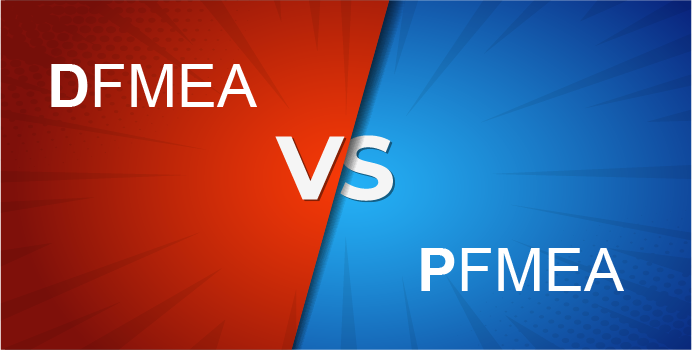What is the key difference between DFMEA and PFMEA?


There is a lot of difference between listening and hearing: GK Chesterton
Introduction
Failure is part and parcel of our lives! Does it mean that we should plan the failure? The simple answer is NO. In life, there are many instances when we analyze the present state and based on that decide our future course of action. Example: If someone is planning to migrate to a different country, if all possible positives and negatives are weighed systematically, there is a high possibility that whatever decision will be taken, will fulfill the expectations.
Objective
The FMEA is a deep dive analysis process of identifying possible internal and external failures.
The key objective of implementing the FMEA (Failure Mode and Effect Analysis) manual is to improve robustness, performance, effectiveness, and efficiency of the product and manufacturing processes. The indicator to achieve it depends upon the linkage of FMEA with COQ (Cost of Quality) so that business performance can be improved.
Definitions
Design for Assembly (DFA): the process by which products are designed with ease of assembly considerations. (e.g., if a product contains fewer parts it will take less time to assemble. thereby reducing assembly costs)
Design for Manufacturing (DFM): integration of product design and process planning to design a product that is easily and economically manufactured
Design for Manufacturing and Assembly (DFMA): the combination of two methodologies: Design for Manufacture (DFM), which is the process of optimizing the design to be easier to produce, have higher throughput, and improved quality; and Design for Assembly (DFA), which is the optimization of the design to reduce risk of error, lowering costs and making it easier to assemble
Detailed Information
FMEA (Failure Mode & Effect Analysis) is a team-oriented, systematic, qualitative, and analytical method to identify, analyze and mitigate the technical risks related to the product and manufacturing process design.
The FMEA is the ‘Before the Event’ and not the ‘After the Event’ exercise.
When FMEA is implemented effectively, it not only impacts the organization in the form of improved performance but also their bottom line (profitability).
- “Failure Modes” means the ways, or modes, in which something might fail. Failures are any errors or defects, especially ones that affect the customer and can be potential or actual.
- “Effect Analysis” refers to studying the consequences of those failures.
DFMEA (Design Failure Mode and Effect Analysis): is a systematic group of activities used to recognize and evaluate potential systems, products, or process failures. DFMEA identifies the effects and outcomes of these failures or actions.
Key objective: of DFMEA is to identify potential product failures associated with a part that could cause:
- Product malfunctions
- Shortened product lifetime
- Safety hazards while using the product
PFMEA (Potential Failure Mode & Effect Analysis): is a methodical approach used for identifying risks on process changes. The Process FMEA initially identifies process functions, failure modes their effects on the process.
Key objective: is to identify potential process failures associated with a part that could cause:
- Process Inefficiency
- High Cost of Poor Quality (COPQ)
- Safety hazards during the manufacturing process
Common points
- DFMEA and PFMEA are LIVE documents
- Severity should remain SAME in DFMEA and PFMEA when the failure effects are the same
- When the ‘product’ failure affects the end-user, it should be interlinked in the PFMEA also.
- Both DFMEA and PFMEA are ‘Before the Event’ exercise
The following are some of the key differences between DFMEA and PFMEA:
| S.No. | DFMEA | PFMEA |
| 1 | DFMEA ensure that organization has a Quality Product | PFMEA ensures that the organization has a reliable and efficient manufacturing process for that product |
| 2 | DFMEA is aligned with the 2nd phase of the APQP process (Product Design and Development) | PFMEA is aligned with the 3rd phase of the APQP process (Process Design and Development) |
| 3 | DFMEA should be initiated in the early stages of the product design | PFMEA should be initiated before planning for the tooling and manufacturing development process |
| 4 | DFMEA focuses on design problems | PFMEA focuses on process problems |
| 5 | DFMEA analyses the functions of a system, subsystem, or component of interest as defined by the boundary/block diagram | PFMEA analyses the potential failures of the processes like manufacturing, assembly, and logistics processes |
| 6 | Some of the key inputs while preparing DFMEA includes Block (Boundary) diagram, P Chart (Parameter), Bill of Material (BOM) | Some of the key inputs while preparing PFMEA includes the output of drawing, DFMEA, Process Flow Chart, and key deliverable at each stage |
| 7 | The next step after DFMEA output includes Design Verification Plan and Report (DVP & R), PFMEA, etc. | The next step after PFMEA output includes Process Control Plan |
| 8 | DFMEA does not rely on the process controls to overcome potential design weaknesses | While preparing PFMEA, it is assumed that product design related possible failures are been considered |
Present Challenges
- How many organizations are using FMEA 1st edition although it has been released since June 2019?
- How often does the top management link FMEA effectiveness with the decrease in COPQ (Cost of Poor Quality)?
- How often both DFMEA and PFMEA are fancy tables to impress the customers and auditors?
- In how many organizations FMEA is a LIVE document?
References:
IATF 16949: 2016
FMEA Handbook (AIAG-VDA 1st Edition June 2019)
Industry Experts
This is the 119th article of this Quality Management series. Every weekend, you will find useful information that will make your Management System journey Productive. Please share it with your colleagues too.
Your genuine feedback and response are extremely valuable. Please suggest topics for the coming weeks.

Thank you sir for representing above mentioned videos worth watching it???
Thanks Sameer for your feedback and encouragement